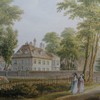 Text search Text search
 Related images Related images
 HistoryWorld HistoryWorld
 Link Link
 Map Map
Click the icons to visit linked content. Hover to see the search terms. |
|  |
| | | | | | | |
|
| 1824 |
| | | George IV lays the foundation stone for a school on the north east side of Kew Green and gives £300 on condition that the school be called the King’s Free School. Later Queen Victoria permits the school to be called The Queen’s School. | | 
| |
|
| 1837 |
| | | The King's Free School in Kew, changing its name by now according to the sex of the sovereign, becomes the Queen's Free School | | 
| |
|
| 1837 |
| | | The Taylor estate of East Sheen and West Hall passes to the Leyborne-Pophams of Littlecote in Wiltshire | | 
|  | West Hall in Kew, by William Harriott, 1819
|
|
|
| 1837 |
| | | William IV returns a small section of the Green to the inhabitants of Kew. | | 
| |
|
| 1838 |
| | | The Public Records Act creates the Public Record Office with headquarters in existing buildings on the Rolls Estate in Chancery Lane, in the City of London | | 
| |
|
| 1840 |
| | | Queen Victoria gives Kew Gardens to the nation, as a botanic garden of scientific importance | |    
| |
|
| 1841-51 |
| | | Sir William Hooker, the first Director of Kew Gardens, rents Brick Farm and re-names it West Park | | 
| |
|
| c. 1844 |
| | | Richard Turner wins the government contract to build a great new glasshouse in Kew Gardens, the Palm House, with Decimus Burton acting as architectural consultant. | | 
| |
|
| 1845-1885 |
| | | Under Sir William Hooker (director 1845--65) and his son Sir Joseph Hooker (director 1865--85) the botanic gardens are greatly increased in size, prestige and scientific excellence. | | 
| |
|
| 1848 |
| | | The Palm House, today "the world's most important surviving Victorian glass and iron structure" is completed. Although originally told to hide it among trees, Kew's director William Hooker succeeds in placing it in a prominent position, thanks to support from Queen Victoria and Prince Albert. | | 
| |
|
| | | | | |
| |